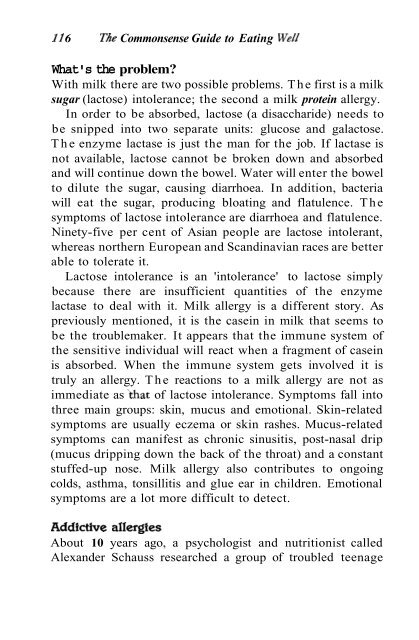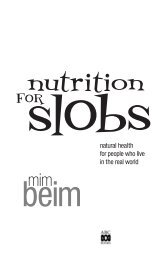Eating Well - Beaming with Health
Eating Well - Beaming with Health
Eating Well - Beaming with Health
Create successful ePaper yourself
Turn your PDF publications into a flip-book with our unique Google optimized e-Paper software.
lf 6<br />
The Commonsense Guide to <strong>Eating</strong> <strong>Well</strong><br />
What's the problem?<br />
With milk there are two possible problems. The first is a milk<br />
sugar (lactose) intolerance; the second a milk protein allergy.<br />
In order to be absorbed, lactose (a disaccharide) needs to<br />
be snipped into two separate units: glucose and galactose.<br />
The enzyme lactase is just the man for the job. If lactase is<br />
not available, lactose cannot be broken down and absorbed<br />
and will continue down the bowel. Water will enter the bowel<br />
to dilute the sugar, causing diarrhoea. In addition, bacteria<br />
will eat the sugar, producing bloating and flatulence. The<br />
symptoms of lactose intolerance are diarrhoea and flatulence.<br />
Ninety-five per cent of Asian people are lactose intolerant,<br />
whereas northern European and Scandinavian races are better<br />
able to tolerate it.<br />
Lactose intolerance is an 'intolerance' to lactose simply<br />
because there are insufficient quantities of the enzyme<br />
lactase to deal <strong>with</strong> it. Milk allergy is a different story. As<br />
previously mentioned, it is the casein in milk that seems to<br />
be the troublemaker. It appears that the immune system of<br />
the sensitive individual will react when a fragment of casein<br />
is absorbed. When the immune system gets involved it is<br />
truly an allergy. The reactions to a milk allergy are not as<br />
immediate as ,that of lactose intolerance. Symptoms fall into<br />
three main groups: skin, mucus and emotional. Skin-related<br />
symptoms are usually eczema or skin rashes. Mucus-related<br />
symptoms can manifest as chronic sinusitis, post-nasal drip<br />
(mucus dripping down the back of the throat) and a constant<br />
stuffed-up nose. Milk allergy also contributes to ongoing<br />
colds, asthma, tonsillitis and glue ear in children. Emotional<br />
symptoms are a lot more difficult to detect.<br />
Addictive allergies<br />
About 10 years ago, a psychologist and nutritionist called<br />
Alexander Schauss researched a group of troubled teenage



